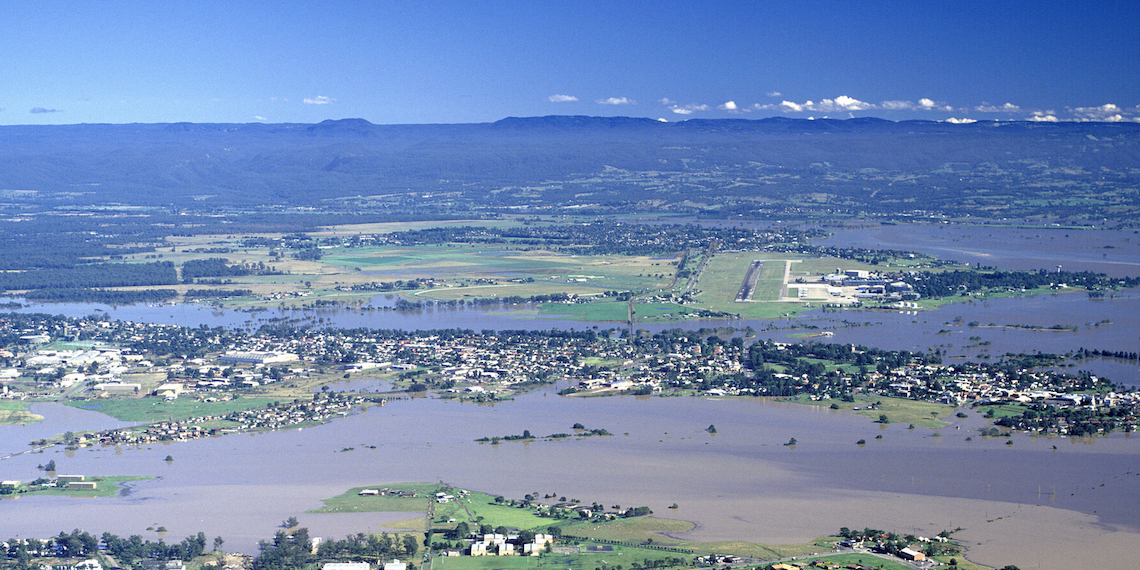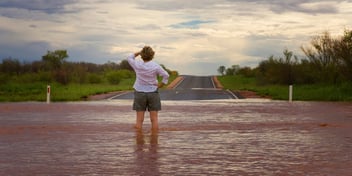Flood risk management under a changing climate

As increasing rainfall intensity and variability continue to make flood risk management more complex and difficult, one global flood risk expert says building resilience is all about taking a multi-pronged approach to preparing and adapting to flood risk.
AECOM’s global flood risk management and resilience practice lead Doug Bellomo said that there is growing recognition within industry that trying to “control” flood water is becoming an increasingly expensive solution.
“Historically, the primary mode of managing flood risks has been to build hardened structures – levees and channels – so we would see water less frequently on certain parts of land or up against certain types of assets,” he said.
“The future, while not certain by any stretch of the imagination, is clearly pointing in the direction that flood hazards will grow over time. We have to go beyond trying to control flooding and start living with it by having proper land uses and building codes in place.
“In order to position ourselves to more effectively live with flooding, we need to find ways of adapting away from the ‘control’ approach and lean into a position that recognises it may very well be too expensive to continue to do these control works everywhere all the time.”
Bellomo said that one of the biggest challenges posed to effective floodplain management by climate change is variability, but that the gravity of the problem is offering up plenty of opportunities to deliver new and innovative approaches to risk management.
“There are clear trends that flood hazards are growing and, along with those, flood risks. Equally disturbing is an increase in variability,” he said.
“The swings from drought to flood are creating a lot of challenges, because it's hard to have a flood conversation in the middle of a drought, and vice versa. But this variability is something we need to pay a lot of attention to.
“While we are getting better at talking about uncertainty, as we move forward in an environment where we can’t use the past to predict the future, we have to find opportunities to communicate risks more clearly.
“Climate change has allowed us to think more deeply about how to create co-benefits and there is plenty of great work that can be done so long as we are prepared.”
The middle way
Bellomo said he has seen great success in managing flood risk where authorities focus on blue-sky investments and where they focus more on post-flood adaptation, but there's an approach in the middle that may be most helpful.
“There have been successes where local municipalities and jurisdictions have gone to great lengths to calculate how much risk they have and start to queue their capital improvement projects to reduce those risks over time,” he said.
“They have established an acceptable level of risk, knowing that they are not going to get it to zero. I would call this a peacetime approach, where incremental investments are made to reduce risks to existing infrastructure.
“But I’ve also seen communities with strong leaders adapt after the disaster effectively. However, those successes are hard to repeat.”
Bellomo said taking a hybrid approach that blends the two can generate more resilient solutions.
“One thing I’ve noticed is that not all communities have the resources to invest in flood mitigation, but many have a vision and hopefully time to think through what they might do differently should a disaster strike,” he said.
“One approach they might apply is to contemplate how you might emerge from potential future crises much stronger and communicate that to those most at risk.
“This means that when the resources do become available, you are not starting those conversations for the first time. Maybe you have already decided on a fair market land price, maybe they have already thought about where they would move next.
Bellomo said this preparative approach is about doing what can be done before the event, but also having a solid plan for what might occur after the event and communicating all of this to others so that they are thinking about change before the next event.
“Change is hard, and we need to provide people with lead time. But the capability to recover quickly and fully, and the capability to adapt, are a really good combination that allows us to imagine something different,” he said.
Dealing with risk
While calculating risk is important work, Bellomo said it's essential to open up the units of measurement beyond economics to ensure we settle on the best solutions.
“Engineers, like myself, like to quantify things and calculate uncertainties. Risk is a very interesting thing in that most people gravitate towards economic risk and return on investment. And that’s all well and good. But you can also think of risk in other terms, like life-loss,” he said.
“It’s important to think about risk as having different units of measure and finding solutions specific to those, too. For example, the potential for habitat loss due to flooding can be quantified in acres or square kilometers. While there are ways to put an economic value on that, the loss almost seems trivialised by that.”
In terms of what to do with risk once quantified, Bellomo said developing a way of dealing with that risk is just as important and offers five key practices of risk management to consider: reduce, transfer, avoid, leverage and accept.
“One thing people don’t often think about is what you do with the risk once it’s quantified. Most gravitate towards risk reduction, which does need to be done in many places. But there is also the risk transfer avenue, such as using insurance mechanisms,” he said.
“The other thing to do is think more about avoiding future risks. We can put building codes and land use practices into effect that help to avoid that risk growing over time.
“But it is also possible to leverage flood risk. If you have a flood risk or a drought problem, is there a way to use those two challenges to help solve both issues? From an integrated water resources perspective, we can accomplish some of this.”
Bellomo said that, of all the approaches to risk management available, accepting risk is the area that needs much more attention, particularly as risks increase.
“We have a lot of work to do with respect to risk acceptance. Low probability–high consequence risks are hard to manage because they can be written off as so unlikely there is no need to worry, or conversely so catastrophic that some outside source will come in and help handle it. The result is a do-nothing posture that can just make the challenge worse,” he said.
“Dismissing the risk as too unlikely or suggesting someone else will take care of it is not truly accepting the risk. Truly accepting risk means being accountable for what happens which many are not prepared to do.
“More open and honest conversations around who owns what risk when it comes to flooding is a great start, but we’ll need to go further if we want to stop floods from surprising us and truly improve how we manage it as a collective.”



